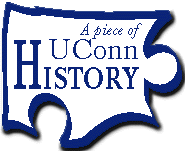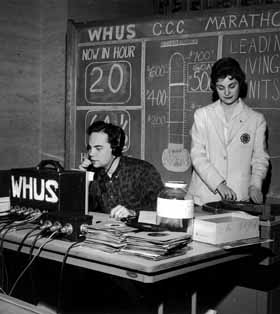|
This is an archived article.
For the latest news, go to the Advance
Homepage
For more archives, go to the Advance Archive/Search Page. |
||||
|
Campus
Community Carnival Raised Money
for Charity for More Than 40 Years It used to happen every spring. Thousands of students gathered on campus to have fun and raise money for charity. One faculty member was quoted in May of 1954 as saying that if the students "put half as much effort into their studies, they would all get 'A's." The Campus Community Carnival drew upon the pent-up energies of students, as they faced the closing weeks of the academic year and final exams. It also raised tens of thousands of dollars for charity over four decades. It began in the spring of 1948 as the Community Chest Carnival, with 10 tents on the midway and booths operated by fraternities, sororities and independent residence halls as a way of raising money for charities. The overall event was sponsored by Alpha Phi Omega, the service fraternity that still operates on campus. Each year the event grew larger, eventually including a campus-wide parade that rivaled the Homecoming parade for its many student-designed and crafted floats. Trophies were awarded for the best and most creative floats, and citations were presented to the residence halls that raised the most money at their carnival booths.
The main event was the midway, held on Fairfield Road, the Student Union Mall, and, in later years, in the old ROTC hangar on Hillside Road. And what began as a weekend became, in the early 1970s, a week or more of activities. Dunking booths, kissing booths, turtle races and a variety of carnival games attracted the attention of students, faculty and staff, as well as their dimes and quarters. In 1957 it was reported that the carnival had raised more than $40,000 in its first nine years. That year, about $5,500 was collected, which went to programs including the Girl and Boy Scouts, the American Red Cross, the Mansfield Volunteer Fire Department, the Windham Hospital Fund, and the Mansfield Nursing Association. By 1960, the event was "the third largest carnival of its type in the United States, and the largest on the eastern seaboard," reported The Connecticut Daily Campus, as UConn's student newspaper was known at that time. Along the way, WHUS, the student radio station joined in, with an annual marathon that attracted pledges from students. In 1953, the marathon ran nearly 45 hours and raised $423.29; in 1961, the pledges, ranging from 25 cents to $25, amounted to $1,375 from an 81-hour marathon. By the 1970s, the marathon worked this way: student disc jockeys played an annoying recording they called 'The Gong Gong Song' (the actual title was 'I'm Blue') for its use of off-key bangs and gongs in the chorus. Students would phone in to get that song off the air and have their request played instead, all for a pledge toward the carnival charities. When there were no pledges, the "Gong Gong Song" was played over and over, with the DJs urging listeners to make a pledge and get the song off the air. The radio marathon and the carnival may have been victims of their own success, as well as of changing student attitudes. The 1972 event raised a record $19,000 that year, well above the goal of $12,000. The total was fueled by a record $8,669 from the WHUS marathon, which ran for 85 hours. By that year, the carnival had raised more than $165,000 for charity since it began. The goal in 1973 was $20,000 but only $16,227 was raised, and interest in the annual event began to wane. There were fewer and fewer activities and, by 1978, only the radio marathon was held. The last carnival was held in 1979, with a walkathon that raised about $1,000 toward a goal of $10,000. And with that event, after more than 40 years, the Campus Community Carnival became a part of UConn history. In its later years, the event became overshadowed by a concert, which usually capped off the carnival's closing hours. Not that student service and charitable giving have disappeared - in the 1980s and into the '90s there were annual 'Jail and Bail' events to support the American Cancer Society, and other charitable fund-raising efforts. And in the early 1990s, the Office of Community Outreach was established, to coordinate student involvement in a variety of causes and volunteer activities, from Habitat for Humanity to the annual dance marathon for the Connecticut Children's Hospital. In this way, the spirit of the Campus Community Carnival lives on. Mark J. Roy |


